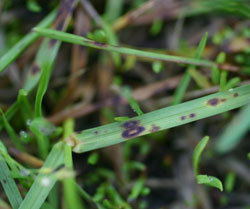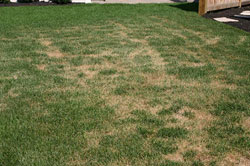
When does leaf spot happen?
Leaf spot and melting out diseases occur in lawns that are stressed from excessive nitrogen fertilizer, excessive water and a very short mowing height. Two separate fungi cause the diseases, but, because the diseases often occur together, they’re considered a single disease complex.
What does leaf spot look like?
Leaf spot symptoms include small, purple-to-black spots on individual leaf blades. The spots become elliptical in shape and may be surrounded by a purple border. Tissue in the center of the spot may die and turn a beige or straw color. If a spot extends across the leaf, the blades wither and die.

What is melting out?
Melting out is the more serious of the two diseases. Initially, its symptoms are similar to those of leaf spot. But as the disease progresses, the fungus works its way to a plant’s base and attacks the crown and roots. Affected turf appears yellowish, thin and shabby with irregular patches of dead grass. When these areas are raked, dead grass plants are easily removed.
When do these diseases occur?
Both diseases occur when dry weather alternates with cloudy, wet periods and cool to moderate temperatures. Poor irrigation coverage, which causes turf to turn yellow or brown and to thin out, may cause symptoms resembling those of leaf spot; irrigation coverage should always be checked if this disease is suspected.

Can some grasses be resistant to leaf spot?
Bluegrass varieties sold in today’s sod blends and mixtures are quite resistant to leaf spot. Some bluegrass varieties sold in “big-box” stores or in “contractor mixes” are older varieties that are susceptible to this disease and should be avoided. Leaf spot is more common on lawns that were seeded or sodded prior to 1980, because the bluegrass varieties used during that time had relatively poor resistance to leaf spot. An old lawn that experiences leaf spot every year is a good candidate for renovation or overseeding with newer, more disease-resistant bluegrass varieties.
Unless a lawn was seeded with older, low quality bluegrass cultivars, those seeded or sodded after 1980 rarely would require fungicides to control the leaf spot/melting out disease complex. Proper lawn-management practices – taller mowing, adequate fertilization, and proper irrigation – usually will control the problem. Older lawns suffering from this disease should be renovated instead of being treated annually with fungicides.



